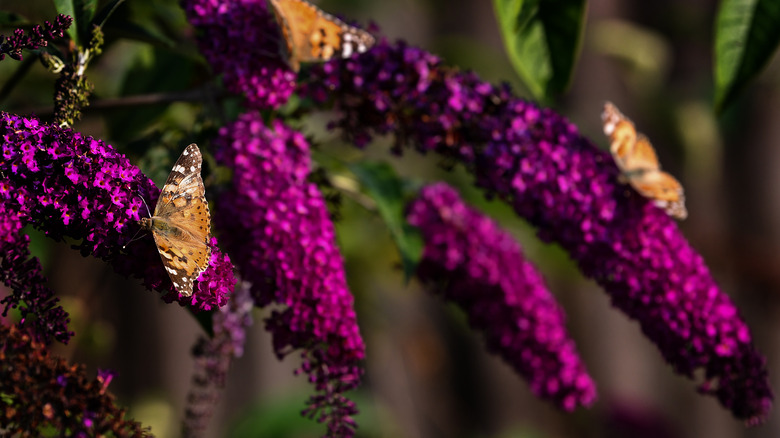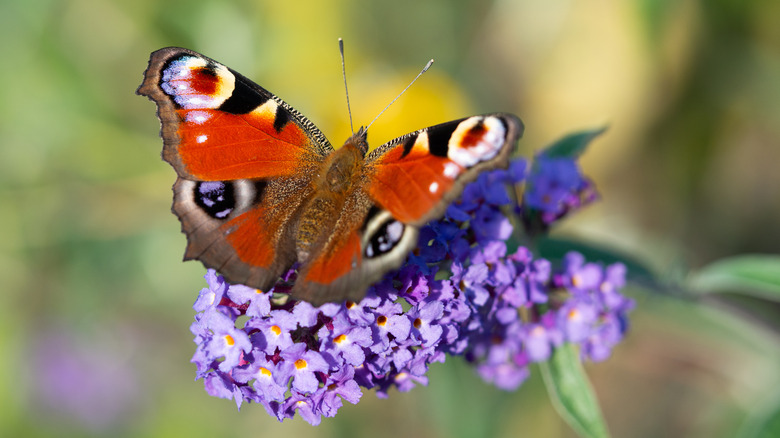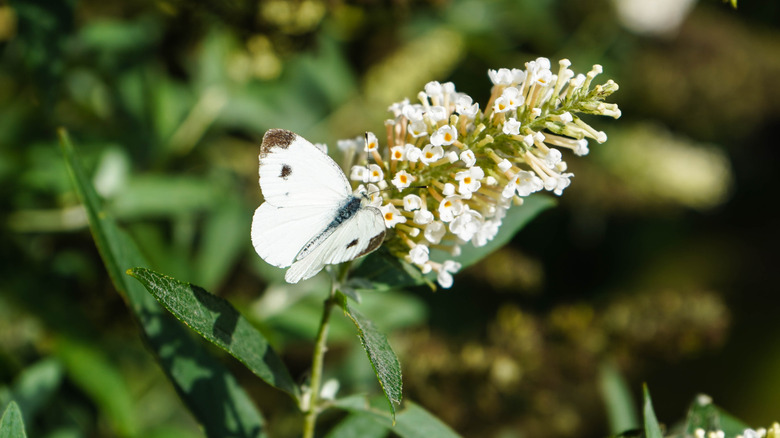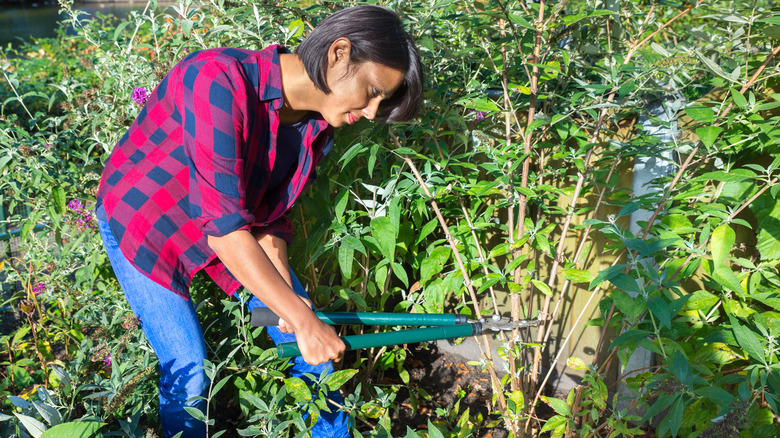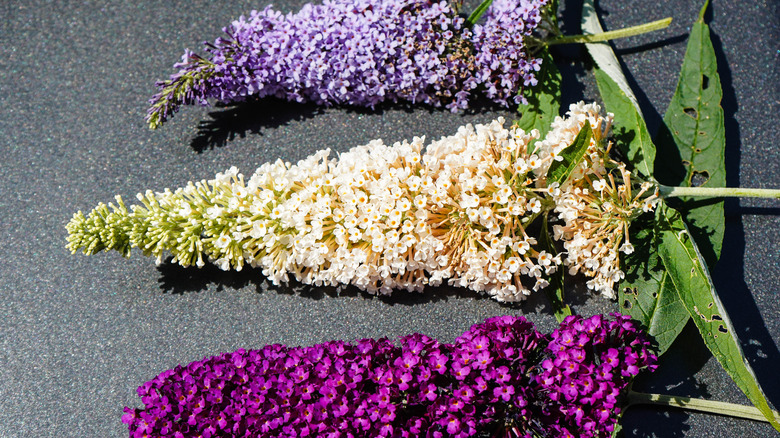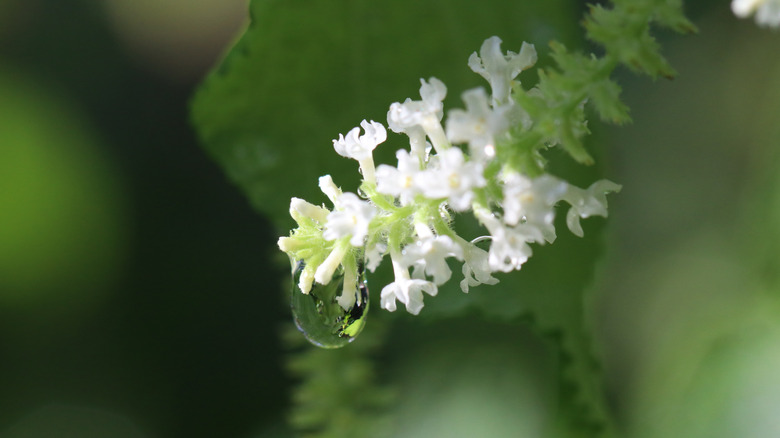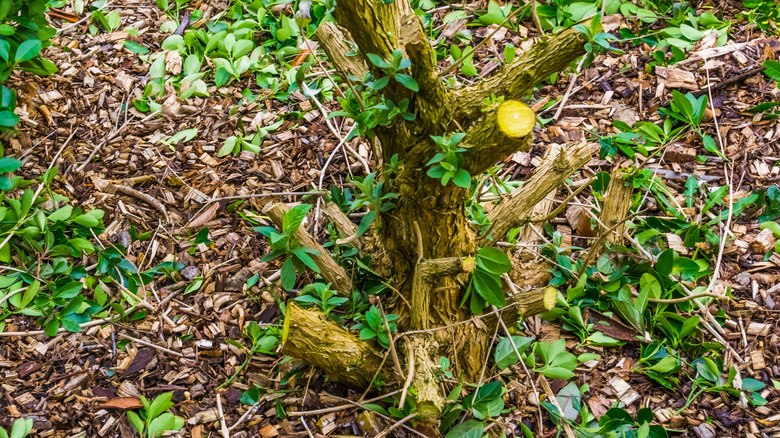The Best Way To Care For A Butterfly Bush
The butterfly bush, scientifically known as buddleia davidii or buddleja davidii, is renowned for its capacity to attract butterflies and other pollinators with its flower clusters that smell sweet. Its bushes can reach a height of 6 to 12 feet and a width of 15 feet, and from June to September, they are in full flower, with leaves of a gorgeous green with a white underside and arching stems. The shrub produces fragrant flowers that grow in the style of cone-shaped wands with lengths ranging from 6 to 18 inches. Butterfly bushes come in various colors, including white, yellow, red, pink, and purple tones ranging from lavender to nearly black.
The buddleia butterfly bush is native to China and Japan, but it has no natural predators in North America. However, because the wind carries its seeds easily, it is considered an invasive pest across much of the eastern United States, and along the West Coast, according to Penn State Extension. As a result, some jurisdictions have outlawed the sale and planting of butterfly bushes. So before growing them in your garden, you should check with municipal regulations.
How to use the butterfly bush in the garden
These plants, with their blue-purple flower clusters peeking out of the bush, and a swarm of butterflies and bees visiting the blossoms as soon as it gets warm and sunny, catch your eye. The butterfly bush became famous as an ornamental plant in Europe and later in other parts of the world due to its beauty and ease of cultivation. Its popularity stems from the fact that the plant grows quickly, flowers early in its life cycle, and produces flowers for up to 30 years. However, as mentioned by Gardening Know How, they are listed as invasive plants in several states in the U.S.; for that reason, gardeners prefer sterile varieties like "Miss Ruby," "Asian Moon," and "Blue Chip."
The butterfly bush flowers have a pleasant scent and are attractive, blooming in large clusters for many days in a row. These plants rely on pollinators for reproduction since their flowers require cross-pollination to create seeds, with butterflies usually doing pollination in their natural habitat. Despite being perennials, most varieties die in the winter, especially in the country's northern parts, with the roots sprouting new stems the following season. This means that if you want a low-maintenance evergreen garden, they are not the best pick.
How to grow butterfly bushes
The low-maintenance buddleia trees are an excellent choice for novice gardeners. Butterfly bushes should be planted in the early spring, just after the last frost has passed, so that you can enjoy their lovely blooms in the summer. The buddleia butterfly shrubs are simple to cultivate and maintain, and this ease of care begins with the planting process. Planting buddleia is a simple weekend job that can blend nicely with your other spring garden activities. American Meadows recommended picking an area that receives plenty of sunshine — it's best if your butterfly bush gets at least eight hours of light per day, but make sure it gets a minimum of six.
Plant the shrubs in their native habitat; they don't need a lot of nutrients in their soil, and they really prefer light, sandy planting sites. Before digging, make sure to aerate the soil with a claw or a trowel, and don't bother adding compost to the planting area. The previous soil line on the stem of your butterfly bush should be level with the ground when you plant it. Next, fill the hole with soil, working it around the roots as you go. When the hole is halfway full, push the soil down to remove any air pockets. Then, fill up the rest of the hole, making a "saucer" of soil around the plant so it can retain plenty of water and water it well in the next few weeks.
How to care for the butterfly bush
Butterfly bushes aren't picky about the sort of soil they grow in; they prefer medium-fertility soil that is wet yet well-drained. However, they are drought-resilient once grown, requiring only supplemental irrigation during protracted summer dry periods. As SFGate recommended, butterfly bushes thrive in soil pH levels ranging from 6.00 to 8.5 on the pH scale. These gorgeous bushes that attract butterflies require wet soil and full sun to thrive throughout the growing season. A lack of sunlight will result in poor growth and prevent flowers from blooming.
The most crucial butterfly bushes care tip is to saturate them with water during their first year after planting when they form the roots. Drought-resistant, the buddleia butterfly bush doesn't like moist soil; thus, proper drainage is essential. You can also skip the fertilizer on butterfly bushes since it promotes excessive leaf growth rather than flower development. Furthermore, it would help to prune butterfly bushes regularly to keep them from becoming too unmanageable. By dead-heading blossoms as soon as they fade, you can encourage the blooming of fresh flowers through the first frost of the fall season while simultaneously limiting seed propagation.
Non-invasive butterfly bush varieties
While the native buddleia davidii is invasive, GardenMandy.com noted, particularly in warmer climates, plant breeders have developed various types of butterfly bushes with the gorgeous blossoms and pollinator-attracting properties of the native form without the risk of the plant taking over your garden.
-
"Miss Pearl" has pure white blooms and grows to about 5 feet tall by 5 feet wide. It is hardly found in zones 5 through 9.
-
"Miss Molly" has bright pink flowers on plants that reach a height and width of 5 feet. It can be grown in zones 5 through 9.
-
"Asian Moon" has dark purple blossoms and grows up to 7 feet tall and 5 feet broad, making it an excellent alternative to "Black Knight," which is invasive. It can be grown in zones 6 through 10.
-
"Lo and Behold" is a range of butterfly bushes ranging from blue through purple, pink, and white. These smaller species grow to around 2 feet tall and wide and are ideal for compact gardens or container gardening.
-
"Flutterby" is a non-invasive butterfly bush that grows to around 2 to 3 feet tall and broad, making it an excellent choice for small gardens. This line comes in several colors, including blue, purple, pink, and white, and can be found in zones 5 through 11.
Is the butterfly bush toxic?
Butterfly bushes aren't edible, but they're no more poisonous than any other garden plant. Planting them in areas where children, dogs, cats, and other animals live should be safe, Honker noted. However, even categorized as non-toxic, you should not allow children or pets to eat them, as they could still cause stomach upset. The butterfly bush is believed to be ornamental only to the extent that no one would identify it with the well-known moniker of "eye guardian." In fact, this Chinese herb is quite beneficial in the treatment and prevention of human eye diseases. The buddleia tree also has a few other health functions, including clearing heat, nourishing the liver, and removing nebula.
The butterfly bush doesn't pose a threat to domestic animals, livestock, and other animals. In fact, deer avoid these somewhat charming shrubs. On the other hand, they attract hummingbirds and butterflies, feeding them nectar.
How to repot a butterfly bush
Repotting is one of the most effective techniques to divide and renew your plant's soil and nutrients, Plantophiles mentioned. On that note, transplanting a butterfly bush requires some site preparation. Remember that butterfly bushes thrive in wet, well-drained soil in full to partial sun, so, before planting, make sure the spot you've chosen matches these requirements and enrich the soil with compost for the best results. However, butterfly bushes need very little upkeep after they have been transplanted, and the process is similar to repotting any other plant.
First, remove the butterfly bush plant from its existing site by gently digging it up and unearthing as much of the root system as possible before moving it to its new position. Next, lift the plant, roots, and soil from the ground and place them in the newly made hole. Fill up the hole around the root with backfill and make sure there are no air pockets in the soil by tamping it down. After planting, water the butterfly bush often until the roots have set themselves up; when they do, the butterfly bush plant will require less water and eventually become drought-tolerant.
